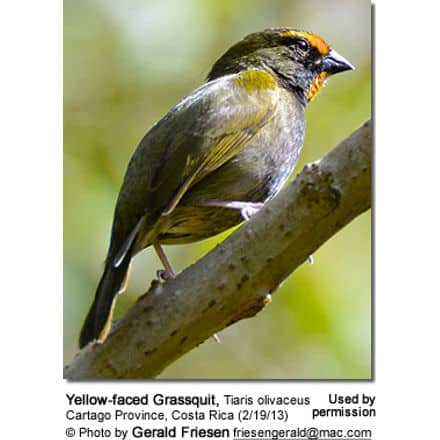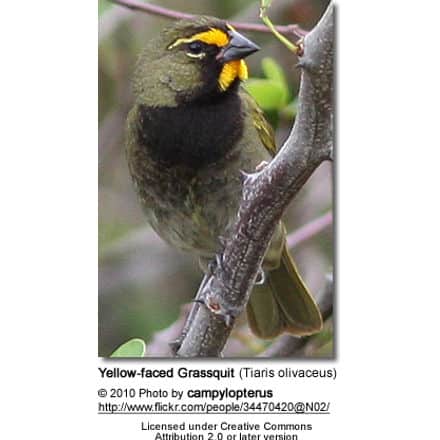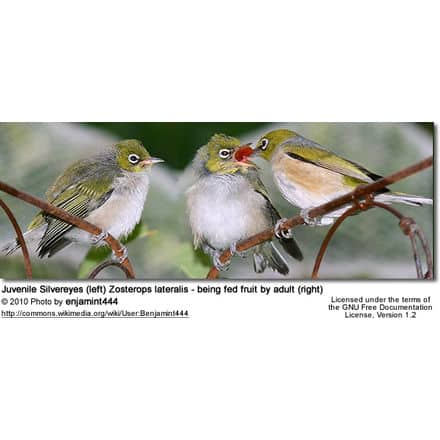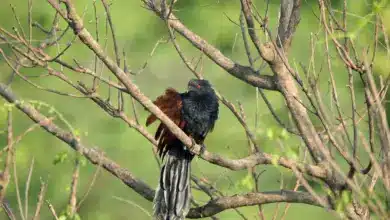Yellow-faced Grassquits (Tiaris olivaceus)
The Yellow-faced Grassquits (Tiaris olivaceus) – also known as Bryant’s Grassquits or Olive finches – are small, greyish-green birds that occur naturally in the Central American tropics and surrounding regions.
They are closely related to the well-researched Darwin’s finches.
They are quite common with an expansive range and their conservation status is assessed as of “Least Concern.”

Distribution / Habitat
The range of the Yellow-faced Grassquits stretches from central Mexico south to northern Ecuador and northwestern Venezuela. They are also found on the Greater Antilles and nearby islands (such as the Cayman Islands and Jamaica). They have been introduced to Hawai’i.
They are mostly resident (non-migratory), but some movement has been noted amongst non-breeding birds with the occasional records of them in the United States.
They inhabit lowlands and foothills areas up to 7,500 ft (2,300 m) altitude. They are found in semi-open areas, such as such as roadsides, pastured, weedy fields and low scrub. They tend to avoid dry grassland areas and areas with very low growth.
These sociable birds are known to form loose mixed-species feeding flocks.
Subspecies and Ranges:
- Yellow-faced Grassquit (nominate) (Tiaris olivaceus olivaceus – Linnaeus, 1766)
- Range: Cuba, Isle of Pines, Jamaica and Cayman Islands
- Yellow-faced Grassquit (ssp. pusillus) (Tiaris olivaceus pusillus – Swainson, 1827)
- Range: Gulf lowlands of eastern Mexico south to Colombia and western Venezuela
- Yellow-faced Grassquit (ssp. intermedius) (Tiaris olivaceus intermedius – Ridgway, 1885)
- Range: Cozumel and Holbox Islands off the Mexican Yucatán Peninsula
- Yellow-faced Grassquit (ssp. ravidus) (Tiaris olivaceus ravidus – Wetmore, 1957)
- Range: Isla Coiba in Panama
- Yellow-faced Grassquit (ssp. bryanti) (Tiaris olivaceus bryanti – Ridgway, 1898)
- Range: Puerto Rico
Description
Size
Measures 3.9 – 4.2 inches (10 – 10.7 cm) in length – including the tail. They weigh between 0.28-0.35 oz (8 – 10 g), depending on subspecies.
Plumage Details / Adults
The male has a black forehead, sides of face and of throat, and chest. The crown, back, wing coverts, and tails are olive green. His throat and “eyebrows” (superciliary) are bright yellow. The flight feathers are dusky, edged with olive green. The bend of the wings are yellow. Below he is greyish olive.
Gender ID
The female is slightly smaller than the male. The plumage is a dull olive-green above. Her plumage below is a paler grey. She may have some dark smudges on the chest. The face patterns are a duller yellow. Her lower beak is dark horn-colored.
Other Physical Details
- Small bird
- Dark, cone-shaped, sharply pointed bill (more pointed than those of the related seedeaters)
- Dark eyes
- Legs and feet grey
Juvenile Description
Immature birds look like adult females, except for a duller plumage and dull pale “eyebrows” (superciliaries) and chins. Young males molt into their adult plumage in their first year.
Similar Species
Males are not easily confused due to their contrasting facial pattern. Females are more difficult to identify. The cone-shaped and pointed beak is most helpful in separating this species from the similar Seedeater family (genus Sporophila). The seedeaters have more rounded beaks.
Diet / Feeding
Yellow-faced Grassquits mostly feed on grass seeds, such as Paspalum sp., Digitaria adscendens, Eragrostris sp., and Panicum sp. (Skutch 1954, Rubenstein et al. 1974). When their favored grass seeds aren’t available, they will also eat other seeds, berries and some insects.
They will also retrieve nectar from flowers. They glean insects of the foliage or pick them off the ground. Grass seeds are often taken directly from tall grasses or they are gathered from the ground.
Breeding / Nesting
Breeding Saison: Mostly during summer months, but may nest throughout the year, with the exception of February to April.
Courtship: Male performs a nuptial dance, during which he vibrates his wings and sings for the female while sitting close to the female
Nesting: Nest in loose nesting colonies. The domed nest is constructed using compacted grasses, straw and weed stems. The nest is lined with soft plant material and shredded fibers. The entrance is on the side of the nest. The nest location is typically in a grass tussock or in a low bush, typically less than 1 ft (30 cm) above the ground.
Eggs: The average clutch consists of 2 – 3 white eggs with brown marks. The female alone broods the eggs for 12 to 14 days until hatching. Both parents feed the nestlings regurgitated seeds.
Calls / Vocalizations / Sounds
https://xeno-canto.org/154204/embed?simple=1
Alternate (Global) Names
Chinese: ???? … Czech: Knežík žlutolící, kubánka velká … Danish: Stor Cubafinke .. Dutch: Grote Cubavink, Grote Cuba-vink … Finnish: Kultakurkkusirkkunen … French: Chanteur à face jaune, Cici grand-chanteur, Grand Chanteur de Cuba, Sporophile à face jaune, Sporophile grand chanteur, Tiaris à face jaune … German: Goldbraue, Goldbrauen-Gimpelfink, Großer Kubafink … Italian: Erbero facciagialla, Fringuello cantore facciagialla … Japanese: kimayukubiwasuzume … Norwegian: Gulstrupegresspurv, Stor kubafink … Polish: kubanik wiekszy, kubanik wi?kszy … Russian: ?????????? ??????-??????, ????????? ?????? … Slovak: ostrov?an trávový … Spanish: Ciguíta de Hierba, Gorrión Barba Amarilla, Semillerito Cariamarillo, Semillero Cariamarillo, Semillero Oliváceo, Semillero Tomeguín, Tomeguín de la Tierra … Swedish: Större kubafink
Beauty Of Birds strives to maintain accurate and up-to-date information; however, mistakes do happen. If you would like to correct or update any of the information, please contact us. THANK YOU!!!




